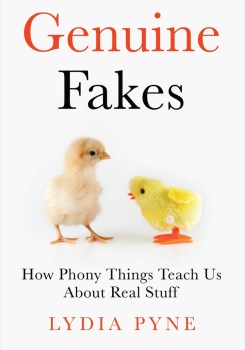How The First Non-Natural Diamond Was Grown In A GE Lab
Since ancient times, people have tried to make their own diamonds. In upstate New York in 1954, it finally happened.
by Lydia Pyne, on February 21, 2020
The following is an excerpt from Genuine Fakes: How Phony Things Teach Us About Real Stuff by Lydia Pyne.

"The first non-natural diamonds were made in General Electric’s laboratories in December 1954.
Ever since Lavoisier and Tennent’s experiments, scientists and engineers had known that they needed to subject carbon to enormous amounts of heat and pressure in order to transform it into a diamond, but just how to pull this off required no small amount of trial and error. As demonstrated in the experiments of Hannay, Moissan and even Parsons, creating immense amounts of pressure is difficult, if not downright dangerous. But, their early experimental designs weren’t necessarily flawed—they just needed different technologies and manufacturing to be able to create those pressures in the lab. The answer came from the American Nobel-winning physicist Percy Bridgman, who worked with the development of a vertical hydraulic piston that pressed into a cylinder, which created 4,200 atmospheres of pressure through a complex anvil system. For years, Bridgman’s laboratory at Harvard had holes in the walls where the canister—affectionately known as ‘The Bomb’—blew out and embedded materials in the walls. Bridgman, it was reported, superstitiously never had the holes repaired.
By the 1940s, the General Electric Research Laboratory in Schenectady, New York, had become the centre of synthetic diamond research, bringing together researchers from chemistry, physics and industrial engineering. (Schenectady had a long tradition of supporting speculative research projects even if they weren’t directly related to the production of electrical equipment.) The team was made up of Francis Bund, Herbert Strong, Howard Tracy Hall (generally H. Tracy Hall or Tracy Hall in popular literature), Robert Wentorf and James Cheney, and was managed by Anthony Nerad. The project was code-named “Project Superpressure” and everyone was sworn to secrecy. Drawing on Bridgman’s work, Superpressure used several different apparatuses in its experiments. For years, the team devoted extraordinary time, effort and resources to making synthetic diamonds—and, more importantly, to learning how to manufacture them in a way that was replicable. As the years went by, the management at General Electric began to worry that manufacturing diamonds would turn out to be gimmicky at best and a total monetary sinkhole at worst. By December 1954, the team needed concrete, tangible results—diamonds—to justify its work.
On the evening of 8 December 1954, Herbert Strong began Experiment 151, setting the pressure cone apparatus at an estimated 50,000 atmospheres, cranking the temperature up to 1250°C (2282°F), and depositing a carbon and iron mixture with two small natural diamonds to seed diamond crystal growth. It was not unlike the methods used by Hannay decades earlier, only Strong was clearly using seed crystals. (Research in the Soviet Union used seed diamonds as part of the effort to grow diamonds, as near as General Electric could tell.) Most of Strong’s earlier experiment runs had been short, a couple hours at most. But this time he decided to let Experiment 151 mimic nature—which took millions of years to produce diamonds—and, at least, to extend the time of the experiment and let it run overnight.
On the morning of 9 December, the two seed crystals tumbled out freely, unchanged in the crucible. A blob of the iron-carbon mixture had melted into one end of the tube and Strong sent the blob to the metallurgy division to be polished. A bit miffed, metallurgy sent back a message on 15 December, informing Strong that they were unable to polish his sample because it was destroying the polishing wheel. Whatever was in the blob was strong and hard—hard enough to gouge metallurgy’s equipment—and only a diamond could be that tough. Strong recounts, “The entire group gathered around to inspect the hard point. Initially there was a moment of stunned silence. Could it possibly be diamond? Finally, Hall spoke the verdict: ‘It must be diamond!’” Subsequent X-ray analysis confirmed that the diamonds in question were, in fact, laboratory made.
“Instantly, my hands began to tremble. My heart beat wildly. My knees weakened and no longer gave support. Indescribable emotion overcame me and I had to find a place to sit down!”
On 16 December 1954, Hall performed a similar experiment by himself, using an older bit of technology, a high-pressure press called a belt. He added two diamond seed crystals to iron sulphide and placed everything in a cylindrical graphite heater. Carefully following the belt protocol he had designed after months of working with the apparatus, he placed thin disks of tantalum metal between the sample and the belt anvils to facilitate current to heat the sample. Everything was cooked at 1600°C (2912°F) under 100,000 atmospheres of pressure. The entire experiment took 38 minutes.
“I broke open a sample cell after removing it from the Belt. It cleaved near that tantalum disk,” Hall said of his discovery, after seeing flashes of light from octahedral crystals that were stuck to the disk. “Instantly, my hands began to tremble. My heart beat wildly. My knees weakened and no longer gave support. Indescribable emotion overcame me and I had to find a place to sit down!” In Hall’s mind, there was no doubt about the results. “I knew that diamonds had finally been made by man.”
Suddenly, after years of research and in the space of a mere week, General Electric had two possible ways to manufacture diamonds. In the weeks that followed the question wasn’t so much whether researchers could make diamonds. The question was whether they could make them again according to either Strong’s or Hall’s experiment designs. Which method was better?
Researchers spent weeks trying to duplicate Strong’s results and never could. (Strong contended that the heat had fluctuated significantly during the night of Experiment 151 and that fluctuation ... "
https://www.sciencefriday.com/articles/ ... e-excerpt/